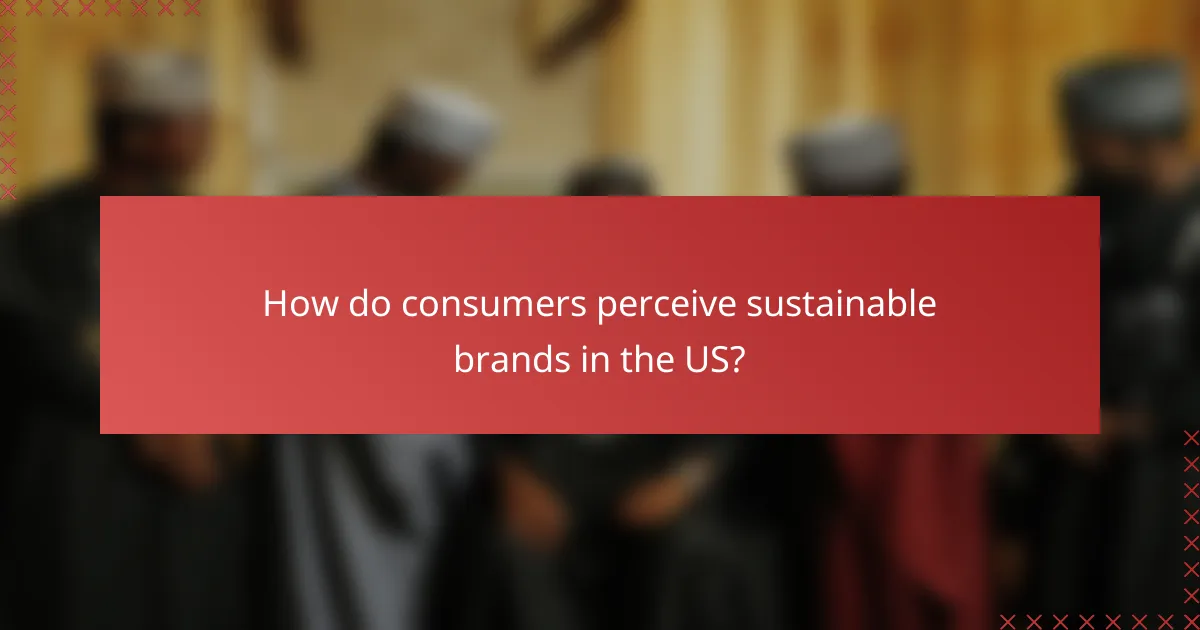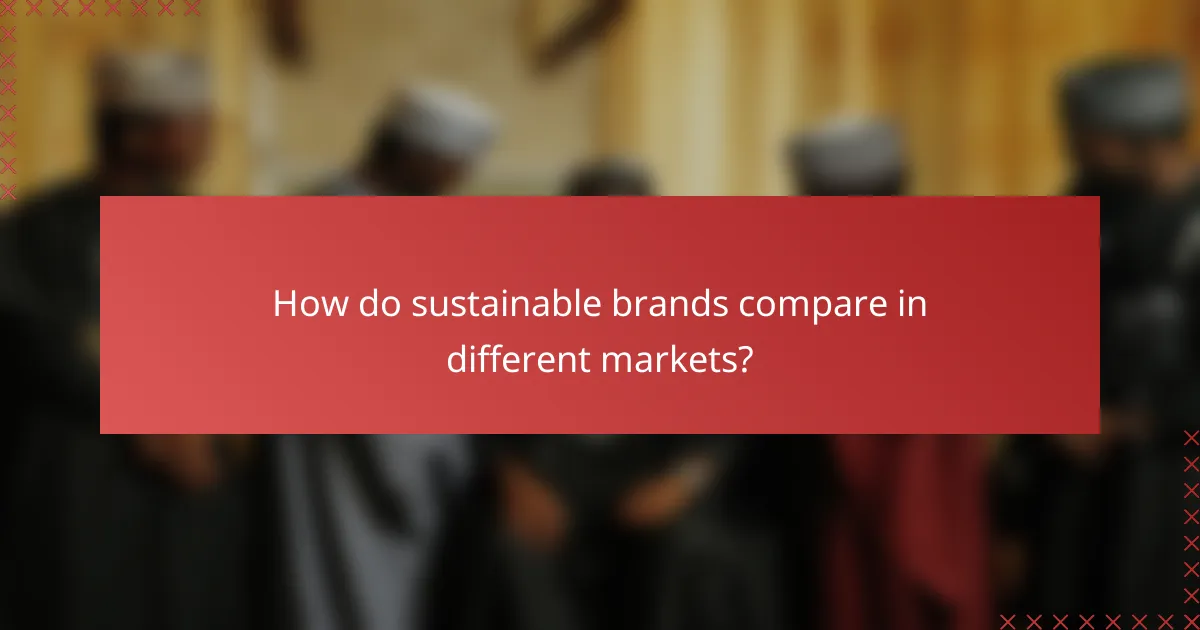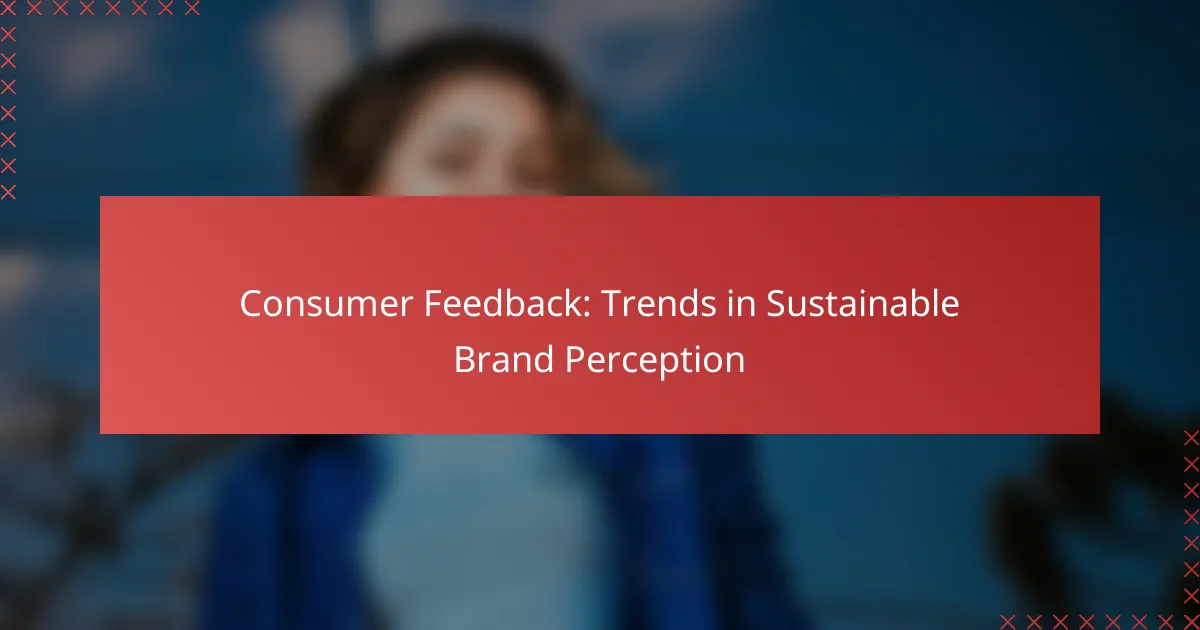As consumers become increasingly aware of sustainability issues, their perception of brands that prioritize eco-friendly practices is evolving. Trust and responsibility are now key attributes associated with sustainable brands, driving demand for transparency and local sourcing. By actively engaging with consumer feedback, brands can refine their strategies to align more closely with the values and expectations of their audience.

How do consumers perceive sustainable brands in the US?
Consumers in the US increasingly view sustainable brands as trustworthy and responsible, often associating them with positive environmental and social impacts. This perception is shaped by growing awareness of sustainability issues and the desire for brands that align with personal values.
Positive brand associations
Sustainable brands often cultivate strong positive associations among consumers, linking their products to eco-friendliness and ethical practices. Brands that transparently communicate their sustainability efforts, such as using recycled materials or fair trade sourcing, tend to enhance their reputation and attract like-minded customers.
For example, companies like Patagonia and Seventh Generation have successfully built their identities around sustainability, gaining consumer trust and admiration. These associations can lead to increased word-of-mouth referrals and a loyal customer base.
Increased loyalty among eco-conscious consumers
Eco-conscious consumers are more likely to remain loyal to brands that demonstrate a commitment to sustainability. This loyalty often translates into repeat purchases and a willingness to pay a premium for products perceived as environmentally friendly.
Research indicates that a significant portion of consumers, particularly millennials and Gen Z, prioritize sustainability when making purchasing decisions. Brands that engage in sustainable practices can foster deeper connections with these demographics, enhancing customer retention.
Impact on purchasing decisions
Consumers’ purchasing decisions are increasingly influenced by a brand’s sustainability practices. Many shoppers actively seek out products that are labeled as organic, biodegradable, or carbon-neutral, reflecting a shift towards more conscious consumption.
To capitalize on this trend, brands should clearly communicate their sustainability initiatives through marketing channels and product labeling. Offering certifications, such as USDA Organic or Fair Trade, can further validate a brand’s commitment and sway consumer choices in their favor.

What are the current trends in sustainable brand perception?
Current trends in sustainable brand perception highlight a growing consumer demand for transparency, eco-friendly practices, and local sourcing. Brands that effectively communicate their sustainability efforts are more likely to gain consumer trust and loyalty.
Rise of transparency in supply chains
Consumers increasingly expect brands to be transparent about their supply chains. This includes disclosing information about sourcing, manufacturing processes, and labor practices. Brands that provide clear insights into their supply chains can enhance credibility and foster trust among environmentally conscious consumers.
To meet this demand, companies can utilize tools like blockchain technology to trace product origins and share this information with customers. This transparency not only satisfies consumer curiosity but also aligns with ethical standards that many shoppers prioritize.
Preference for eco-friendly packaging
There is a notable shift towards eco-friendly packaging as consumers become more aware of environmental issues. Brands that use biodegradable, recyclable, or minimal packaging often attract customers who prioritize sustainability. This trend is particularly strong among younger demographics who are willing to pay a premium for greener options.
Companies can enhance their appeal by adopting innovative packaging solutions, such as compostable materials or reusable containers. Offering incentives for customers to return packaging can also promote sustainable practices and strengthen brand loyalty.
Growth of local sourcing initiatives
Local sourcing initiatives are gaining traction as consumers seek to support their communities and reduce carbon footprints. Brands that prioritize local suppliers not only contribute to the economy but also appeal to consumers who value freshness and quality in their products.
To capitalize on this trend, businesses can highlight local partnerships in their marketing efforts. This can include showcasing local ingredients or materials in their products, which resonates well with consumers looking for authenticity and sustainability in their purchases.

How does consumer feedback influence brand strategies?
Consumer feedback plays a crucial role in shaping brand strategies by providing insights into customer preferences and expectations. Brands that actively listen to feedback can adapt their approaches to better align with consumer values, particularly regarding sustainability.
Adaptation of marketing messages
Brands can refine their marketing messages based on consumer feedback to resonate more effectively with their target audience. For instance, if consumers express a strong preference for eco-friendly products, brands can highlight their sustainable practices in advertisements and promotional materials.
Utilizing social media platforms for real-time feedback allows brands to adjust their messaging quickly. This responsiveness can enhance brand loyalty and attract environmentally conscious consumers.
Product development based on consumer insights
Consumer insights are invaluable for guiding product development, especially in the realm of sustainability. Brands can use feedback to identify gaps in their product offerings, such as the demand for biodegradable packaging or cruelty-free ingredients.
Engaging with consumers through surveys or focus groups can provide direct input on desired features, leading to products that better meet market needs. This iterative process can significantly increase the likelihood of product success.
Enhancement of customer engagement practices
Effective customer engagement practices are essential for building strong relationships with consumers. Brands can leverage feedback to create personalized experiences, such as tailored recommendations based on previous purchases or preferences.
Additionally, fostering open communication channels, like feedback forms or community forums, encourages ongoing dialogue. This not only helps brands stay attuned to consumer needs but also cultivates a sense of community among customers who share similar values.

What metrics are used to measure sustainable brand perception?
Metrics for measuring sustainable brand perception include various tools that assess consumer attitudes towards a brand’s environmental and social practices. Key metrics such as Net Promoter Score (NPS), brand trust index, and consumer sentiment analysis provide insights into how consumers view a brand’s commitment to sustainability.
Net Promoter Score (NPS)
Net Promoter Score (NPS) gauges customer loyalty and satisfaction by asking respondents how likely they are to recommend a brand to others. This metric is particularly useful for understanding consumer perception of a brand’s sustainability efforts, as higher scores often indicate a positive view of the brand’s environmental practices.
To calculate NPS, survey participants rate their likelihood to recommend on a scale from 0 to 10. Scores are then categorized into promoters (9-10), passives (7-8), and detractors (0-6). A strong NPS can signal that consumers feel positively about a brand’s sustainability initiatives.
Brand trust index
The brand trust index measures consumer confidence in a brand’s integrity, reliability, and commitment to sustainable practices. This index is crucial as trust can significantly influence purchasing decisions, especially among environmentally conscious consumers.
To assess brand trust, surveys often include questions about consumers’ perceptions of a brand’s transparency, ethical behavior, and social responsibility. A high brand trust index indicates that consumers believe in the brand’s sustainability claims, which can enhance loyalty and advocacy.
Consumer sentiment analysis
Consumer sentiment analysis involves evaluating public opinion about a brand through social media, reviews, and surveys. This analysis helps brands understand how their sustainability efforts are perceived in real-time, allowing for quick adjustments to marketing strategies.
Tools for sentiment analysis often use natural language processing to categorize feedback as positive, negative, or neutral. Brands can leverage this data to identify trends, address concerns, and enhance their sustainable practices, ultimately improving overall brand perception.

What role do social media platforms play in shaping perceptions?
Social media platforms significantly influence consumer perceptions of brands, particularly in the realm of sustainability. They serve as channels for information sharing, allowing consumers to engage with brands and each other, which can enhance or diminish brand reputation based on public sentiment.
Influencer partnerships
Influencer partnerships are a powerful tool for brands aiming to enhance their sustainable image. By collaborating with influencers who prioritize eco-friendly practices, brands can reach targeted audiences that value sustainability. For instance, a fashion brand might partner with eco-conscious influencers to showcase their sustainable clothing lines, effectively leveraging the influencer’s credibility.
However, brands should carefully select influencers whose values align with their own to avoid backlash. Authenticity is crucial; consumers can quickly detect insincerity, which can damage brand trust.
User-generated content
User-generated content (UGC) plays a vital role in shaping brand perceptions, especially regarding sustainability. When consumers share their experiences with a brand’s sustainable products, it creates a sense of community and trust. Brands can encourage UGC by hosting contests or campaigns that invite customers to share their sustainable practices using specific hashtags.
Brands should actively engage with this content, showcasing it on their platforms to reinforce positive perceptions. Highlighting real customer stories can enhance credibility and foster a deeper connection with the audience.
Real-time feedback mechanisms
Real-time feedback mechanisms, such as polls and surveys on social media, allow brands to gauge consumer sentiment about their sustainability efforts. These tools enable brands to quickly adapt their strategies based on consumer input, ensuring they remain aligned with audience expectations.
Implementing these mechanisms can be as simple as using Instagram Stories to ask followers about their views on sustainable practices. Brands that respond to feedback demonstrate their commitment to consumer values, which can strengthen brand loyalty.

How do sustainable brands compare in different markets?
Sustainable brands vary significantly across different markets, influenced by local consumer values, economic conditions, and regulatory environments. In some regions, consumers prioritize eco-friendliness, while in others, affordability or brand reputation may take precedence.
Regional differences in consumer expectations
Consumer expectations for sustainable brands differ widely by region. In Europe, for instance, there is a strong emphasis on transparency and ethical sourcing, with many consumers willing to pay a premium for products that meet these standards. In contrast, North American consumers may focus more on the overall value and functionality of sustainable products rather than their environmental impact.
In Asia, expectations can vary greatly between urban and rural areas. Urban consumers often seek innovative sustainable solutions, while rural consumers may prioritize practicality and cost-effectiveness. Understanding these regional nuances is crucial for brands aiming to succeed in diverse markets.
Brands should conduct thorough market research to identify specific consumer preferences in each region. Tailoring marketing strategies to align with local expectations can enhance brand perception and drive sales. For example, a brand might highlight its eco-certifications in Europe while emphasizing affordability in North America.
